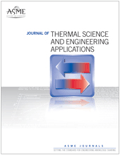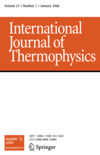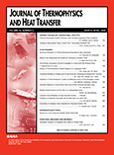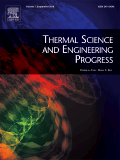
HEAT AND MASS TRANSFER
Scope & Guideline
Advancing thermal insights for a sustainable future.
Introduction
Aims and Scopes
- Heat Transfer Mechanisms:
Investigates various fundamental heat transfer processes including conduction, convection, and radiation, and their applications in different systems and materials. - Mass Transfer Phenomena:
Explores the principles and applications of mass transfer, including diffusion, absorption, and adsorption processes in various engineering contexts. - Thermal Management Systems:
Focuses on innovative designs and technologies for thermal management in electronic devices, HVAC systems, and renewable energy applications. - Nanofluids and Advanced Materials:
Studies the thermal properties and applications of nanofluids and advanced materials in enhancing heat transfer performance. - Experimental and Numerical Methods:
Utilizes both experimental and computational approaches, including CFD (Computational Fluid Dynamics), to analyze and optimize heat and mass transfer processes. - Sustainable and Energy-Efficient Technologies:
Promotes research on sustainable technologies, including energy-efficient heat exchangers, renewable energy systems, and thermal energy storage solutions.
Trending and Emerging
- Nanotechnology in Heat Transfer:
Research involving nanofluids and nanomaterials is on the rise, emphasizing their potential to enhance heat transfer efficiency in various applications. - Sustainable Energy Solutions:
There is an increasing focus on sustainable energy technologies, including solar thermal systems, energy storage, and waste heat recovery systems. - Advanced Computational Techniques:
The application of advanced computational methods, such as machine learning and artificial intelligence, to optimize heat transfer processes is gaining traction. - Phase Change Materials (PCMs):
Research on PCMs for thermal energy storage and management is trending, driven by the need for efficient and sustainable heating and cooling solutions. - Smart Thermal Management Systems:
Emerging themes include the development of intelligent thermal management systems that integrate IoT (Internet of Things) for real-time monitoring and optimization of thermal performance. - Biomedical Applications:
There is growing interest in the application of heat transfer principles in biomedical contexts, particularly in hyperthermia treatment and thermal therapies.
Declining or Waning
- Traditional Heat Exchanger Designs:
Research on conventional heat exchanger designs has decreased as newer, more efficient configurations and materials are being prioritized. - Basic Heat Transfer Theory:
Fundamental studies of heat transfer theory are less emphasized in favor of applied research and innovative technologies. - Single-Phase Flow Studies:
Research specifically focusing on single-phase flow in heat transfer applications is waning, with more attention now given to two-phase and multiphase flow dynamics. - Low-Temperature Applications:
Investigations related to low-temperature heat transfer applications are becoming less frequent as research shifts towards high-performance thermal systems. - Fouling Mechanisms in Heat Exchangers:
While still relevant, the focus on fouling mechanisms in traditional heat exchangers has decreased as the community increasingly seeks solutions for enhanced performance and efficiency.
Similar Journals

Journal of Thermal Science and Engineering Applications
Advancing thermal innovation through rigorous research.The Journal of Thermal Science and Engineering Applications is a premier publication dedicated to advancing knowledge in the fields of thermal sciences and engineering applications. Published by the esteemed American Society of Mechanical Engineers (ASME), this journal has been contributing to the scientific community since 2009 and continues to be a platform for innovative research until 2024. With an ISSN of 1948-5085 and an E-ISSN of 1948-5093, the journal is recognized for its rigorous peer-review process and its impact within the scientific community. Notably, it has achieved notable rankings in various categories as of 2023, including Q2 in Engineering (miscellaneous) and Q3 in Condensed Matter Physics, Fluid Flow, and Transfer Processes, and Materials Science. This positions the journal favorably within its field, attracting submissions that reflect both theoretical and practical advancements. While it does not offer open access, its commitment to quality content ensures that it serves as a critical resource for researchers, professionals, and students interested in thermal sciences, engineering innovations, and related interdisciplinary studies. It is a must-read for anyone looking to stay informed on the latest developments and applications in these dynamic areas of research.

INTERNATIONAL JOURNAL OF THERMOPHYSICS
Advancing Knowledge in Thermophysical ApplicationsInternational Journal of Thermophysics, published by Springer/Plenum Publishers, is a premier platform for the dissemination of high-quality research in the field of thermophysics, particularly focusing on the intricate relationships between thermal properties and their applications across various scientific disciplines. With an ISSN of 0195-928X and an E-ISSN of 1572-9567, the journal has established a respected presence in the academic community since its inception in 1980, with a converged publication timeline extending to 2024. Categorized in the Q2 quartile for Condensed Matter Physics in 2023 and maintaining impressive Scopus rankings—such as #39 in Fluid Flow and Transfer Processes and #178 in Condensed Matter Physics—the journal serves as a vital resource for researchers and professionals aiming to advance knowledge in the thermal sciences. Though not an open-access journal, it remains accessible through institutional subscriptions. The International Journal of Thermophysics is committed to fostering innovative research and interdisciplinary collaboration, ensuring that it remains at the forefront of thermophysical studies.

ASME Journal of Heat and Mass Transfer
Bridging Theory and Application in Heat TransferASME Journal of Heat and Mass Transfer, published by the renowned American Society of Mechanical Engineers (ASME), is a pivotal journal in the fields of mechanical engineering and materials science. With its ISSN 2832-8450 and E-ISSN 2832-8469, this journal aims to disseminate high-quality research focused on the principles and applications of heat transfer and mass transfer phenomena. Despite its recent launch, having converged from 2023 to 2024, it has quickly established a significant presence in the academic community, holding respectable rankings within the Scopus database across various categories—including a 66th percentile rank in Mechanical Engineering. The journal endeavors to foster innovation and collaborative research that advance the frontiers of knowledge in thermal sciences, making it an essential resource for researchers, practitioners, and students keen on exploring the challenges and developments in heat and mass transfer technologies. The journal also embraces an open-access model, ensuring that leading research reaches a broader audience and contributes to global knowledge sharing.

Journal of Nanofluids
Fostering Global Collaboration in Nanofluid ResearchJournal of Nanofluids, published by AMER SCIENTIFIC PUBLISHERS, is a leading international journal dedicated to the burgeoning field of nanofluid technology which bridges the areas of fluid dynamics and nanotechnology. With an ISSN of 2169-432X and E-ISSN of 2169-4338, this journal has established itself as a valuable resource for researchers and professionals in Mechanical Engineering and Chemical Engineering, particularly in the domains of fluid flow and transfer processes. Its prestigious standing is reflected in the 2023 Scopus rankings, positioning it in the 79th percentile for Mechanical Engineering and the 78th percentile for Fluid Flow and Transfer Processes. Although coverage has been discontinued in Scopus since 2021, the journal maintains a Q2 category ranking in both relevant fields, emphasizing its commitment to high-quality and impactful research dissemination. This journal aims to foster innovation and collaboration among scientists and engineers worldwide, providing a platform for groundbreaking research, reviews, and discussions on nanofluids, their properties, and applications. As an essential addition to the library of any researcher or student vested in advanced fluid dynamics, the Journal of Nanofluids serves as a pivotal conduit for advancing knowledge and technology in this exciting and evolving field.

JOURNAL OF THERMOPHYSICS AND HEAT TRANSFER
Empowering Researchers in Thermophysics and BeyondJOURNAL OF THERMOPHYSICS AND HEAT TRANSFER, published by the American Institute of Aeronautics and Astronautics, serves as a vital platform for the dissemination of cutting-edge research in the fields of thermophysics and heat transfer. With an ISSN of 0887-8722 and an E-ISSN of 1533-6808, this journal has been pivotal in enhancing our understanding of heat transfer mechanisms since its inception in 1987, continuing through 2024. It occupies a noteworthy position in various academic categories, boasting Q2 rankings in both Fluid Flow and Transfer Processes and Mechanical Engineering, reflecting its significant contribution to the engineering and physical sciences community. Although it currently does not offer Open Access options, the journal’s repository of rigorous peer-reviewed articles remains accessible to researchers, professionals, and students eager to expand their knowledge and apply innovative findings in aerospace, condensed matter physics, and planetary sciences. Emphasizing both theoretical and experimental approaches, the JOURNAL OF THERMOPHYSICS AND HEAT TRANSFER remains an indispensable resource for advancing the frontiers of engineering and applied sciences.

Heat Transfer
Exploring the dynamics of heat transfer across disciplines.Heat Transfer, published by WILEY, is a leading open-access journal dedicated to advancing the field of heat transfer science, encompassing innovative research and application across various domains. With an ISSN of 2688-4534 and an E-ISSN of 2688-4542, the journal aims to provide a platform for researchers to disseminate their findings from 2020 to 2024, focusing on condensed matter physics and fluid dynamics. Ranked in the Q2 category for both Condensed Matter Physics and Fluid Flow and Transfer Processes, it showcases articles that contribute significantly to the understanding and utilization of heat transfer mechanisms. Located in the United States at 111 River St, Hoboken, NJ 07030, the journal appeals to a diverse audience, including academic researchers, professionals in engineering, and students seeking to deepen their knowledge in thermal sciences. With a strong emphasis on accessibility, Heat Transfer promotes the exchange of ideas and experimental techniques, ultimately driving innovation and collaboration in the advancement of thermal management technologies.

Journal of Thermal Science
Connecting theory and practice in the realm of thermal science.Journal of Thermal Science is a prestigious academic publication dedicated to the field of thermal science and its applications. Published by SPRINGER, this journal has been at the forefront of knowledge dissemination since its inception in 1992 and continues to provide a platform for researchers and professionals to share their innovative findings through high-quality peer-reviewed articles. With its ISSN 1003-2169 and E-ISSN 1993-033X, the journal covers a diverse array of topics related to thermal processes, materials, and engineering, significantly contributing to advancements in Condensed Matter Physics. In the latest rankings, it holds a commendable Q2 category in the 2023 quartiles, further highlighting its relevance with a Scopus ranking of #183/434 in its field, placing it in the top 57th percentile. While currently not offering open access, the journal strives to bridge the gap between theory and practice, making substantial impacts on both academia and industry. Its continued exploration of cutting-edge research ensures that it remains a key resource for students and professionals looking to expand their knowledge and foster innovation in thermal sciences.

International Journal of Heat and Technology
Exploring the Frontiers of Heat and Fluid DynamicsThe International Journal of Heat and Technology is a premier academic publication dedicated to the dissemination of innovative research in the fields of thermal engineering, fluid mechanics, and condensed matter physics. Published by the INT INFORMATION & ENGINEERING TECHNOLOGY ASSOCIATION and based in Italy, this journal has been a significant resource for researchers and professionals since its inception in 1983, with a commitment to advancing knowledge until 2024. With an impact factor that reflects its relevance, the journal encompasses diverse topics within its scope, bridging gaps between theoretical research and practical applications. Although currently not open access, the journal provides valuable insights into the nuances of heat transfer, flow dynamics, and material properties, making it a critical reference for academia and industry alike. The journal's Scopus rankings position it within the competitive landscape of chemical and mechanical engineering, highlighting its contribution to advancing these fields. We invite scholars, professionals, and students to engage with the rich content provided within its pages, to foster a deeper understanding of heat and technology in our rapidly evolving world.

Thermal Science and Engineering Progress
Bridging theory and practice in thermal science.Thermal Science and Engineering Progress is a premier peer-reviewed journal published by ELSEVIER, established to bridge the gap between theoretical and practical advancements within the fields of thermal science and engineering. Since its inception in 2017, this esteemed journal has rapidly ascended to a Q1 ranking in the category of Fluid Flow and Transfer Processes, positioning it among the top 17 of 96 journals in this discipline, as reflected by its impressive 82nd percentile ranking in Scopus. With a focus on disseminating high-impact research, Thermal Science and Engineering Progress aims to foster innovation and collaboration by publishing cutting-edge studies that address both contemporary challenges and future directions in thermal management, energy conversion, and heat transfer technologies. Researchers, professionals, and students alike are invited to explore the wealth of knowledge contained within its pages, which are accessible from its headquarters in Amsterdam, Netherlands. This journal plays a critical role in advancing technological progress and fostering a deeper understanding of thermal processes, making it an essential resource for anyone dedicated to these crucial areas of study.

INTERNATIONAL JOURNAL OF HEAT AND FLUID FLOW
Pioneering Research in Heat Transfer and Fluid FlowFounded in 1979, the INTERNATIONAL JOURNAL OF HEAT AND FLUID FLOW is a premier publication in the fields of mechanical engineering, fluid dynamics, and heat transfer, published by Elsevier Science Inc. With an impressive impact factor and ranking in the Q1 category for Mechanical Engineering and Q2 for Condensed Matter Physics and Fluid Flow and Transfer Processes, this journal is highly regarded for its rigorous peer-reviewed articles that contribute significantly to the advancement of knowledge in these critical areas. Researchers, professionals, and students can access cutting-edge studies that explore the intricacies of thermal and fluid systems, ensuring they stay at the forefront of scientific exploration. The Scopus rankings further affirm its role as a leading source of impactful research, with significant placements in crucial academic categories. Join an active community of scholars committed to innovation and excellence in the exploration of heat and fluid flow phenomena.